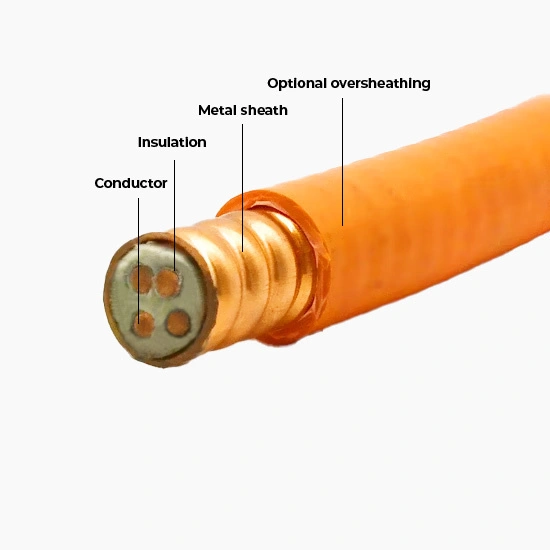Nowadays, as high-rise buildings become more common, we need to prioritize ensuring the safety of people and property. Fire-resistant electrical cables are one of the leading solutions to help prevent fires from spreading through electrical wiring. This article will help you understand this technology and how to apply it in practice.
1. Why are fire-resistant electrical cables needed in buildings?
Did you know that over 30% of fires in high-rise buildings originate from electrical short circuits and spread through the cable system? In a building, thousands of meters of wires run throughout from the basement to the roof, connecting all electrical devices. They contain many potential fire and explosion risks:
- Overloaded, aged, or exposed wires can easily generate sparks.
- Loose or oxidized connections generate large amounts of heat.
- Rodents gnawing on wires and insects invading and containing flammable substances inside the cable sheath.
- Conductors passing through humid areas and corrosive environments.
When an incident occurs, electrical fires can easily spread through common insulation layers and sheaths. A small fire can quickly travel through conduits and erupt into a large blaze, scorching everything in its path, destroying property and threatening human lives.
Therefore, the use of fire-resistant electrical cables is a mandatory requirement for modern constructions, especially high-rise buildings.
2. What is fire-resistant technology for electrical cables?
Fire-resistant technology for electrical cables refers to electrical cables with sheaths made of materials that can resist the spread of fire, contain no halogens, and do not emit toxic smoke when burned. It allows fire alarm, firefighting, and emergency evacuation equipment to continue operating for a certain period of time, helping fire suppression and rescue operations proceed more smoothly.
Their operating principles are based on influencing the elements necessary for combustion, specifically:
- Reducing combustible fuel
- Using special plastic materials: The sheath and insulation layer of fire-resistant cables are usually made from special plastics such as FR-PVC or LSZH (Low Smoke Zero Halogen) which are less flammable and burn more slowly than regular PVC plastic.
- Using flame retardant fillers: Inorganic fillers such as aluminum trihydrate – Al(OH)₃, magnesium hydroxide – Mg(OH)₂ are added to the plastic material. When exposed to high temperatures, these fillers decompose and release water, diluting the concentration of flammable gases and lowering the temperature of the material, thereby slowing down the burning process.
- Preventing the formation and spread of flames
- Charring mechanism: Some fire-resistant materials form a charred layer on the surface when burned. This charred layer acts as a protective barrier, preventing the flame from contacting the material layer underneath, limiting the escape of flammable gases and insulating heat, thereby slowing the spread of fire.
- Cooling mechanism: As mentioned above, flame retardant fillers release water when decomposed, and the water vapor has a cooling effect, reducing temperature and slowing the reaction rate of combustion.
- Gas phase dilution mechanism: Fire retardants can release inert gases (that do not participate in the combustion reaction) when decomposed. These gases dilute the concentration of oxygen and flammable gases in the burning zone, making the combustion process more difficult and slower.
- Limiting smoke and toxic gases
- Using plastics that produce little smoke and contain no toxic halogen gases (LSZH) when burned. This helps improve visibility, reduce the risk of smoke inhalation, and minimize harmful gases in the event of a fire.
3. Types of fire-resistant electrical cables
There are currently 3 popular types of fire-resistant electrical cables on the market:
3.1 Mineral insulated fire-resistant cables
- Structure:
- Conductor: Made of copper material.
- Insulation layer: Magnesium Oxide (MgO) – A granular, inorganic dielectric filler compound with excellent insulating properties even at very high temperatures, non-flammable, does not produce toxic smoke when exposed to fire, and has an extremely high melting point (around 2800°C).
- Metal sheath: Usually made of tubular copper material to protect the conductor core and MgO insulation layer inside. Additionally, this sheath can also be made of special alloys such as Cupronickel (main components are copper, zinc, and nickel) or stainless steel.
- Outer sheath: Optional plastic type suitable for application requirements.
- Advantages: Excellent heat resistance, protection against mechanical impacts, high current carrying capacity.
- Disadvantages: High cost, heavy weight, difficult to bend.
- Applications: Used in high-rise buildings, shopping malls, hospitals, or harsh environments such as factories, chemical plants, industrial zones, etc.
3.2. Silicone fire-resistant cables
- Structure:
- Conductor: Made of copper material.
- Fire-resistant layer: Mica tape.
- Insulation layer: Made of silicone.
- Sheath: Optional material can be PVC, LSZH, etc., depending on requirements.
- Advantages: Good heat resistance, effective fire protection, flexibility, chemical resistance, good water resistance.
- Disadvantages: High cost, limited mechanical durability and application restrictions, only used in special environments such as high temperatures or harsh chemicals.
- Applications: Widely used in manufacturing plants, environments with high risk of fire and explosion such as chemical production, oil and gas, fire alarm systems, aviation, shipbuilding, and ceramic and glass factories, etc.
3.3 LSZH fire-resistant cables
- Structure:
- Conductor: Made of copper material
- Fire-resistant layer: Mica tape
- Insulation: XLPE plastic.
- Round filler layer: LSZH plastic.
- Wrapping tape: Low-smoke zero-halogen fire-resistant tape or glass
- Outer sheath: LSZH plastic.
- Advantages: Good fire resistance, low smoke emission, and halogen-free.
- Disadvantages: Higher price than PVC cables and not as mechanically durable as other types of cables.
- Applications: Suitable for installation in areas requiring a high level of fire safety such as buildings, hospitals, schools, entertainment centers, factories, workshops, etc.
4. Where to install fire-resistant electrical cables in high-rise buildings
The importance of fire-resistant technology for electrical cables has been proven. So specifically, where should we install them in a high-rise building?
4.1. Main electrical system
The main electrical lines of the building such as the electrical backbone, electrical columns, etc., need to be made from fire-resistant cables. When the main system catches fire, all activities in the building will be paralyzed and cause serious damage.
4.2. Basements and technical floors
Basements often concentrate a lot of electrical equipment, dense cable volume, and large electrical loads, requiring very high fire resistance. If a short circuit and fire occurs in the basement, the fire can easily spread to the upper floors through the conduits.
Similarly, the technical floor housing the UPS system, distribution switchboards, etc., is also one of the places prone to fire and explosion and requires high safety.
4.3. Public areas
Corridors, waiting halls, staircases, etc., are crowded areas, often equipped with lighting and signage. The wires leading to these devices need to be of the fire-resistant type to maintain operation when an incident occurs.
4.4. Ventilation and emergency exit systems
Ventilation systems, smoke exhaust fans, and emergency exit lights often operate even during a fire. Therefore, the power supply cables for them must always ensure safety during a fire and prevent toxic smoke from spreading through the air ducts.
5. Notes when installing fire-resistant electrical cables
To maximize the performance of fire-resistant cables, we need to keep in mind a few points:
- Choose the type of fire-resistant cable suitable for the purpose and installation environment. For maximum safety, use cables with the highest possible temperature and pressure resistance.
- The cable surface must be kept intact, not scratched, wet, or mechanically impacted. If the cable sheath is damaged, it will affect the fire resistance performance.
- Ensure that the insulation and sheath layers are not peeled or loose. The distance between the layers must be sufficient to avoid contact and electric discharge.
- When threading through junction boxes and conduits, the cables must be securely fastened, not twisted or bent excessively. Avoid subjecting the cables to excessive tensile force.
- Check the tightness of the connections after installation. The terminals must be tightly sealed, well insulated, and have sufficient heat resistance.
6. Conclusion
Fire-resistant electrical cable technology is an important invention in the field of fire safety in high-rise buildings. With scientific design and advanced materials, this technology can help limit the spread of fire, minimize toxic gas generation, and maintain the fire alarm system's operation in case of a fire.
Investors, engineers, and electricians need to thoroughly understand this technology to apply it correctly. By installing fire-resistant cables in important locations throughout the building, we can contribute to protecting lives and property, enhancing safety and reliability for the construction.

 VN
VN


